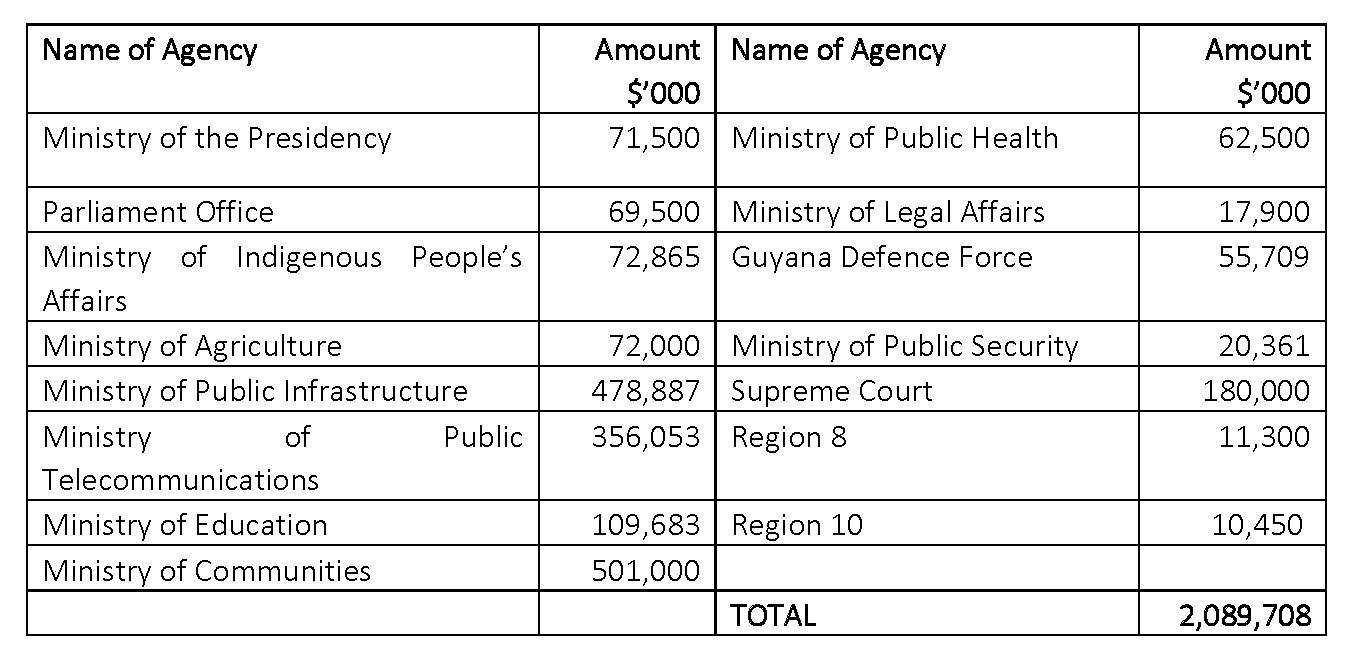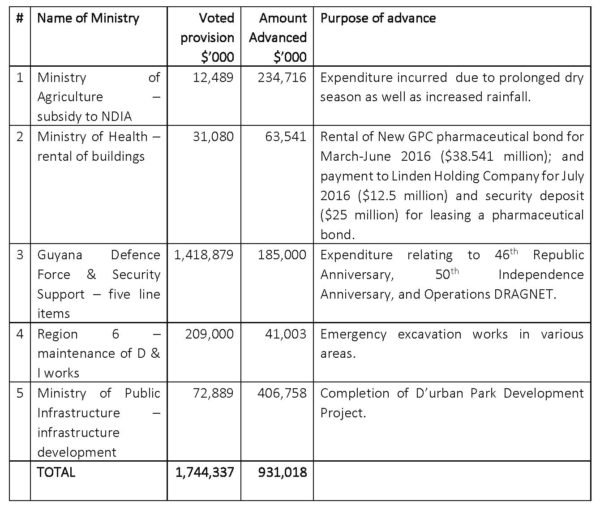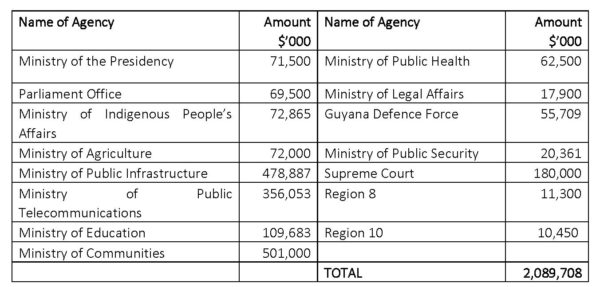Over the last four years, this column has been scrutinizing the various financial papers that have been submitted to the National Assembly for approval. The last such scrutiny was Financial Papers 1/2015 and 2/2015 covering: (a) an amount of $3.240 billion relating to advances from the Contingencies Fund that the former Minister of Finance had authorised during the period 25 October 2011 to 31 December 2014; and (b) excess expenditure totalling $6.471 billion incurred from 1 January 2012 to 16 July 2014 again on the authority of the former Minister.
 I had commented that it was good that the new Administration was taking seriously the task of “cleaning up” the books of the Government and of regularizing matters in order to move forward without contamination with past issues that were left unresolved. The sad reality, however, is that no sanctions were imposed on those responsible for the serious constitutional and legislative violations giving rise to these two papers. It will be recalled that the then acting Chief Justice had ruled that the then Minister of Finance had violated the Constitution as it relates to Financial Paper 2/2015.
I had commented that it was good that the new Administration was taking seriously the task of “cleaning up” the books of the Government and of regularizing matters in order to move forward without contamination with past issues that were left unresolved. The sad reality, however, is that no sanctions were imposed on those responsible for the serious constitutional and legislative violations giving rise to these two papers. It will be recalled that the then acting Chief Justice had ruled that the then Minister of Finance had violated the Constitution as it relates to Financial Paper 2/2015.
Apart from the statement of excess expenditure referred to above which is a rare occurrence, there are two types of financial papers. The first relates to advances made from the Contingencies Fund which the Minister had authorised. This is an emergency fund to be used only for situations of disastrous consequences, such as an earthquake, a great flood, or a civil war, where it was not possible to convene Parliament to approve of additional expenditure to address the emergency. In order to access the Fund, the Fiscal Management and Accountability Act requires the Minister to be satisfied that an urgent, unavoidable and unforeseen need arises for which: (a) no funds have been allocated in the national budget or there is insufficient allocation; (b) funds cannot be reallocated based on the criteria set out in the Act for such reallocation; or (c) the proposed expenditure cannot be postponed without jeopardizing the public interest.
Once advances are granted from the Contingencies Fund, the Minister has the obligation to report at the next sitting of the National Assembly since his previous report, setting out the amounts advanced, to whom the amounts were paid, and the purpose of the advances. The general principle is that the financial paper must be presented to the Assembly at the earliest possible opportunity to enable the Assembly to give its ex post approval of the expenditure and for the replenishment of the amounts advanced from the Fund. The Contingencies Fund is a kind of imprest account, financed out of the Consolidated Fund.
The second type of financial paper relates to the Minister’s request to the Assembly for the approval of additional funds in the form of a Supplementary Estimate, where it is foreseen that there will be an insufficiency of funds to meet expenditure for the rest of the year. In such a situation, there is an approved budget which is the original budget; and a Supplementary Estimate which, when added to the original budget, gives a revised budget. The Assembly’s approval of advances from the Contingencies Fund is in the nature of a Supplementary Estimate and is also reflected in the revised budget.
Last week, the Assembly approved two financial papers in the amounts of $931.018 million and $2.090 billion. The first amount has already been expended by way of advances from the Contingencies Fund while the $2.090 billion represents anticipated shortfalls in budgetary allocations for the rest of the year.
Financial Paper 1/2016
This paper covers advances made from the Contingencies Fund during the period 1 January to 28 July 2016, as summarized below:
There was, however, no catastrophic event or development that would have satisfied the criteria set out above for access to the Contingencies Fund. In addition, Parliament was neither prorogued nor dissolved during this period, and therefore it would have been more appropriate for a Supplementary Estimate to have been sought. (Even if the Assembly is in recess, it can be recalled in the event an emergency.) To the extent that the decision was taken to access the Contingencies Fund, instead of seeking a Supplementary Estimate, there was an abuse in the use of the Fund.
When I was Auditor General, year after year, I had cause to comment on this abuse, as evidenced by the following extract in my 2001 Report:
In previous reports, the abuse of the Contingencies Fund was highlighted. There was clear evidence that the Fund was used to meet routine expenditure when budgetary allocations were exhausted. This was so because recourse to the Contingencies Fund was an easier and more expedient proposition than seeking Supplementary Estimates from Parliament. However, in doing so the intent of the Law was being violated in that the majority of the advances granted from the Contingencies Fund did not satisfy the criteria for the grant of such advances.
It is also evident from the above summary, that the events giving rise to the advances could have been foreseen at the time of budget preparation, for example, preparations for the Republic and Independence anniversaries.
The advance of $63.541 million for the rental of New GPC pharmaceutical bond for March-June 2016; and payment to Linden Holding Company for the rental of a new facility for July 2016 ($12.5 million) and security deposit of $25 million, has been a source of public outcry during the last few days. The Government sought to justify its decision to rent the new facilities on the grounds that it was an emergency situation that required the application of the sole source method of procurement. Sole-sourcing, however, takes place where:
(a) the materials or services are available only from a particular manufacturer, supplier or contractor; or
(b) a particular supplier or contractor has exclusive rights with respect to the materials or services, and no reasonable alternative or substitute exists; or
(c) the materials or services by reason of their complex or specialized nature are available from only one source; or
(d) owing to a catastrophic event, there is an urgent need for the goods, services or construction, making it impractical to use other methods of procurement because of the time involved in using those methods.
In addition, the contracted company has no prior experience in the storage of pharmaceuticals since it was only recently formed; nor did it have a storage facility at the time of entering the contract. It was only in March 2016 that the company entered into an agreement for the acquisition of a residential property for the purpose of providing the storage facility. The sale was completed with the passing of the transport in July 2016. However, those familiar with Sussex Street, Albouystown and its environs, will agree that the area is unsuited for the storage of such sensitive items as drugs and medical supplies. Can we really afford to risk the health of the nation by storing such items at this location?
Concern has also been expressed in relation to the monthly payment of $12.5 million for a 10,000 square feet of storage, compared with $19.2 million for a 70,000 square feet of state-of-the-art specialized storage facility offered by the New GPC. Again, is it worth the risk, considering the need to have such specialized storage, duly certified as fit and proper by an international agency such as PAHO/WHO? While the Government is keen on breaking the New GPC monopoly for the supply of drugs and medical supplies, common sense would dictate that it should continue with the arrangement with the New GPC until a suitable alternative is found that is more cost-effective. Years ago, the Government’s Pharmacy Bond in Kingston, Georgetown, was dismantled to make way for the construction of the Marriott Hotel. A new bond was built at Diamond, East Bank Demerara at a cost of $100 million but was never used. Why was there no consideration in the use of the Diamond facility?
In response to the public outcry over the award of the contract to Linden Holding Company, the President established a three-person sub-committee of the Cabinet to look into the matter. But was it not the same Cabinet that approved of the arrangement in the first place? Having regard to the facts of the case, would it not be more appropriate to rescind the contract?
Financial Paper 2/2016
Financial Paper 2/2016 covers a request for a Supplementary Estimate in the sum of $2.089 billion to meet additional expenditure for the remainder of the year, as summarized below:
As can be noted, the largest item relates to partial settlement of an out of Court deal with the operators of Haags Bosch landfill site. The total award is $1.177 billion, and the outstanding balance to be paid in 2017.
The Ministry of Public Infrastructure request is for the completion of roads, acquisition of engines for M.V. Kimbia and the rehabilitation of an airstrip in Region 9.
Finally, when one reflects on the contents of these two papers, it is evident that there is a greater need for more careful planning of the National Budget to minimize the extent to which Supplementary Estimates have to be requested.








